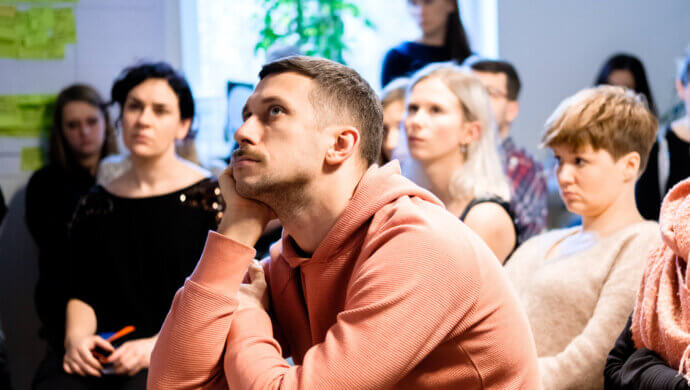Every project is broken down into hours, each specialist has limited availability, and every task with a time estimate is defined and serves as a benchmark for designers and salespeople. What our clients buy from us is a set of high competencies available for a limited time.
As a result, designing behind the scenes is a constant monitoring of time, juggling hours, and training in project craftiness.
Does it have to take that long?
Here are some examples:
To complete a project benchmark, which is just a starting point for discussing the product’s future vision, a designer needs 8 to 16 hours, depending on the complexity of the problem. Involving a senior in this task won’t speed it up much, as there is a process of searching the vast areas of the Internet, selecting examples, and preparing presentations.
Preparing proto-personas for the 3 main roles in the system, along with a set of basic user stories, takes between 10 to 20 hours of focused work.
Preparing real personas requires research on at least six samples, which takes several more days to write a script or link a prototype for testing.
The work can theoretically be sped up by adding another person, but they may not always be available. However, we must factor in the time for synchronisation, onboarding, etc. And of course, adding new people means adding more time to the client’s bill.
Additionally, a specialist must reserve time to respond to emails, fill out timesheets, create meeting notes, and so on.
Having this awareness, I would have shown the surprised client our project process three months ago and calmly explained that each of these tasks is essential, but unfortunately, each requires a certain amount of time and expertise from the specialist. Referring to the well-known saying, you can’t have it cheap, fast, and well made all at once. We’ll have to cut something, give something up, or make some assumptions instead of confirming them through research. Otherwise, we won’t be able to speed up.
However, today I must confidently say that it can be sped up, exactly how much will be revealed in the coming months.

Time reclaimed
At this point, most repetitive tasks that are part of any “office” work can be replaced or effectively supported by AI. Since the topic is hot, you probably already know or even use many of these tools. AI-supported tools can respond to emails, create research scenarios, stimulate creativity, organise data, and perform advanced analyses on data sets at an unimaginable pace. New design tools, using image databases and text instructions from trained designers, can instantly create illustrations, graphic concepts, and even entire interfaces, all at a pace unattainable by humans.
Of course, you may have reservations, laughing at AI’s imperfections, mistakes, simplifications, or confabulations. But even if we assume that “Weak AI” is currently at a junior level, it is not difficult to imagine how quickly, with current funding and market interest, artificial intelligence will gain senior competencies.
Time for experts
Over the past few years, UX DESIGN has become one of the most popular professional havens. Due to the high demand for design services and an insufficient supply in the labor market, companies looking for hands-on help lowered their recruitment requirements, deregulating the market and raising candidates’ expectations. All hands on deck to meet the demand. Especially in situations where
development of design-supporting tools could not keep up with the growing need of digitalising new market sectors during the pandemic. The automation of the design process was slow, and even after years, a human was still needed for almost every task in the digital product creation process.
This time has passed. Because the entrance of AI significantly changes the game strategy. Repetitive, simple tasks can now be performed at lightning speed with minimal human involvement, thus raising the entry threshold into our industry. Companies that employed Figma or Sketch operators instead of educated designers now have to face group layoffs. What has long been automated in other industries is now being automated by AI in the field of design right before our eyes.
That’s why experience, critical thinking skills, analysing specific usage contexts, facilitation, insight, and the ability to draw conclusions and empathy, which are unattainable for AI, are becoming valuable again. As experts, we should seize this moment to emphasize even more strongly our years of experience and the relevance of the decisions we make.
Intelligent tools and UX / AI Designer
Designers have always been supported by tools in their work. In fact, this can be generalized to the entire history of humanity. Without tools, humans would not have built such an advanced culture and would probably still be scribbling deer on cave walls. On the other hand, there are few examples of tools created by humans effectively displacing them from the labor market. Of course, the emergence of new tools always caused changes and the need to adapt to working with them on many levels, from modifying the manufacturing process to a different set of skills required from designers.
This time is no different. The NEW UX DESIGNER must quickly incorporate AI capabilities and potential into their work to maintain their position in the labour market. They must understand that they are a pioneer working with intelligent tools. They must accept that AI may know more, synthesise faster, or have better ideas. They must begin to collaborate with AI, while shaping it in a way that maintains a common purpose and aspirations Instead of ignoring it, start treating AI as a Senior would treat an incredibly talented intern. To achieve optimal collaboration, UX designers need to understand how AI works, acquire the skills to design and research AI, and recognise the advantages and risks of such cooperation.
Joint design manifesto
The UX Design project manifesto is about providing smart solutions to user needs, creating solutions that support experiences in the digital world, reducing barriers to effectively using technology, and providing clients with market-attractive solutions that translate into profits. These goals should also become the goals of smart tools designed by the designer in collaboration with AI.
Just as we take care to avoid black patterns in traditional interfaces, we must also ensure that the solutions we create powered by artificial intelligence do not harm us. Even more so now, our role is to better understand human needs and ensure a healthy balance between needs and a fast-paced economy. We must arm ourselves with guidelines that allow us to design AI tools with thoughtfulness, ethics, and attention to the safety of humanity.
It is especially important for designers to be aware of limitations, such as a lack of empathy or the ability to fully understand socio-cultural context. Without proper supervision from the designer, AI can lead to inappropriate or imperceptible solutions for users. Moreover, there is a risk of excessive reliance on AI, which can lead to a loss of critical thinking and ingenuity.
In future collaboration with AI, UX Designers should balance the benefits of automation with the intuition and empathy characteristic of human designers. The key to success is using AI as a tool that complements the designer’s skills, supports their creativity, and allows them to focus on creating unique experiences for users. With such collaboration, AI and UX designers can jointly contribute to shaping the future of design, where technology supports human needs and aspirations.
Time for innovation
Introducing AI to the design process primarily means greater collaboration between humans and technology. It means moving from treating technology as an object to accepting that technology may have its own opinions on a given subject. Effective collaboration will only be possible if design teams do not compete with AI and focus on human domain activities. While AI will completely take over data analysis, trend research, and outcome prediction, humans will be able to make strategic decisions with twice the effectiveness. As a result, the risk of failure will be minimised, and innovative projects can be implemented much faster.
Thanks to this, the oft-criticised “theater of innovation” evolves, becoming a modern and effective spectacle in which the duo of UX and AI will play a key role.
What do businesses think about it?
We know that rapid changes can cause anxiety. The same is true for the development of AI and business. Regardless of the approach taken towards AI, both optimists and pessimists feel great anxiety and uncertainty about the changes that will occur in the coming years.
Depending on the level of digital awareness, we observe different behaviours. Traditional businesses that have introduced technology to their offices and factories at the minimum level required by the market are rather skeptical. They view the news about AI as a storm in a teacup and do not take the potential impact of AI on their businesses seriously. Companies that have achieved a medium level of technology adoption for their businesses are discussing AI and seeking market support in better understanding the issue. They are also starting to test familiar tools enhanced with AI models on their own. Finally, market leaders who have their own R&D departments have already implemented AI tools into their current production and business processes. They are aware of the benefits and opportunities that come with the new technology and do not intend to lag behind. While rapidly adopting AI, they closely monitor the competition, adjust efficiency metrics, and slow down hiring in potentially easy-to-automate sectors.
However, each of these groups still needs the support of specialists, experts who understand business, technology, and human behaviour. Business Design specialists who can advise on which processes to prioritise for AI modules, Conscious Change Management introducing new work tools sustainably into poorly digitised companies. AI Coaches who can answer a series of emerging questions and concerns.
What is the next step?
Have you wondered what to do with the saved time? Perhaps you’re rubbing your hands together and see an opportunity to implement a larger number of projects? But are you sure you have the right sales potential to reach such a large pool of new contracts?
Perhaps you will conclude that this is a good time to verify the competencies you have on board and consider whether you can sail on the new wave with this set. Investing in new competencies may turn out to be a bullseye.
In the new reality, maintaining high salaries for low-class specialists, whose tasks other companies have just automated, will not be economically viable. Or maybe you will focus on quality and a deeper design process without increasing the cost of the service provided? Your team will focus on a more holistic approach to user experience, including not only digital but the full consumer experience. Like Bronisław Malinowski, you will direct research tools to areas that AI currently does not reach.

Or do you have completely different plans?
The world of design has just shifted into high gear, with a focus on Human-AI Interaction researchers and designers who can create in-house AI-powered solutions, as well as citizen developers who combine knowledge of UX principles with low-code/no-code technology to deliver solutions at the right pace for the AI era.
One thing is certain: human designers will soon not be needed for designing online stores and food ordering applications. Our virtual personalised assistant will order food for us, and how we will discover the world with it will no longer depend on UX/UI Designers, but UX/AI Design.
Inspirations:





